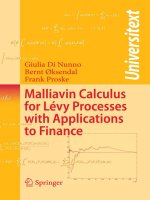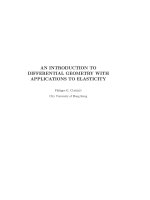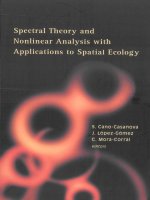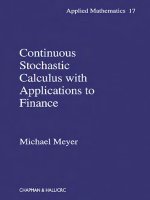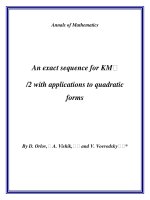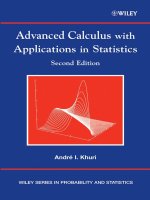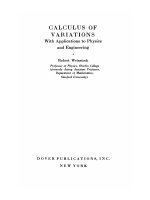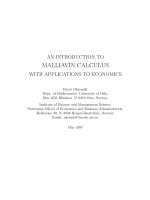Marta sanz sole malliavin calculus with applications to stochastic partial differential equations EPFL press CRC press (2005)
Bạn đang xem bản rút gọn của tài liệu. Xem và tải ngay bản đầy đủ của tài liệu tại đây (1.24 MB, 165 trang )
www.pdfgrip.com
MALLIAVIN CALCULUS
WITH APPLICATIONS TO STOCHASTIC
PARTIAL DIFFERENTIAL EQUATIONS
Marta Sanz-Solé
© 2005, First edition, EPFL Press
www.pdfgrip.com
Fundamental Sciences
Mathematics
MALLIAVIN CALCULUS
WITH APPLICATIONS TO STOCHASTIC
PARTIAL DIFFERENTIAL EQUATIONS
Marta Sanz-Solé
EPFL Press
A Swiss academic publisher distributed by CRC Press
© 2005, First edition, EPFL Press
www.pdfgrip.com
Taylor and Francis Group, LLC
6000 Broken Sound Parkway, NW, Suite 300,
Boca Raton, FL 33487
Distribution and Customer Service
www.crcpress.com
Library of Congress Cataloging-in-Publication Data
A catalog record for this book is available from the Library of Congress.
is an imprint owned by Presses polytechniques et universitaires romandes, a
Swiss academic publishing company whose main purpose is to publish the
teaching and research works of the Ecole polytechnique fédérale de Lausanne.
Presses polytechniques et universitaires romandes
EPFL – Centre Midi
Post office box 119
CH-1015 Lausanne, Switzerland
E-Mail :
Phone : 021 / 693 21 30
Fax : 021 / 693 40 27
www.epflpress.org
© 2005, First edition, EPFL Press
ISBN 2-940222-06-1 (EPFL Press)
ISBN 0-8493-4030-6 (CRC Press)
Printed in Italy
All right reserved (including those of translation into other languages). No part
of this book may be reproduced in any form – by photoprint, microfilm, or any
other means – nor transmitted or translated into a machine language without
written permission from the publisher.
© 2005, First edition, EPFL Press
www.pdfgrip.com
Introduction
Malliavin calculus is a stochastic calculus of variations on the Wiener
space. Its foundations were set in the 1970’s, mainly in the seminal
work [33], in order to study the existence and smoothness of density
for the probability laws of random vectors. For diusion processes this
problem can be approached by applying Hă
ormanders theorem on hypoelliptic differential operators in square form to Kolmogorov’s equation
(see ref. [18]). Thus, in its very first application, Malliavin calculus provides a probabilistic proof of the above mentioned Hăormanders theorem.
Actually the first developments of the theory consist of a probabilistic
theory for second order elliptic and parabolic stochastic partial differential equations with the broad contributions by Kusuoka and Stroock,
Ikeda and Watanabe, Bell and Mohammed, among others. As a sample
of references and without aiming to be complete, we mention [6], [19]
and [28]–[30]. Further developments in the analysis on the Wiener space
led to contributions in many areas of probability theory. Let us mention for instance the theory of Dirichlet forms and applications to error
calculus (see the monograph [8]) and the anticipating stochastic calculus
with respect to Gaussian processes (refs. [45], [46] and [58]). At a more
applied level, Malliavin calculus is used in probabilistic numerical methods in financial mathematics. Many problems in probability theory have
been and are being successfully approached with tools from Malliavin
calculus. Here are some samples together with basic references:
1) Small perturbations of stochastic dynamical systems (refs. [10], [11],
[26], [27] and [31])
2) Weak results on existence of solutions for parabolic stochastic partial
differential equations and numerical approximations (refs. [1] and
[2])
3) Time reversal for finite and infinite dimensional stochastic differential equations (refs. [38] and [39])
4) Transformation of measure on the Wiener space (ref. [66])
5) Extension of Itˆ
o’s formulae (refs. [5] and [41])
6) Potential theory (ref. [15])
© 2005, First edition, EPFL Press
www.pdfgrip.com
vi
Introduction
The aim of this book is to present applications of Malliavin calculus to the analysis of probability laws of solutions of stochastic partial
differential equations driven by Gaussian noises which are white in time
and coloured in space, in a comprehensive way. The first five chapters
are devoted to the introduction to the calculus itself based on a general Gaussian space, going from the simple finite-dimensional setting to
the infinite-dimensional one. The last three chapters are devoted to the
applications to stochastic partial differential equations based on recent
research. Each chapter ends with some comments concerning the origin
of the work developed within and its references. Throughout the paper,
we denote by C a real positive constant which can vary from a line to
another.
The notes were written on the occasion of a visit to the Institut
de Math´ematiques at the Swiss Federal Institute of Technology in Lausanne in Fall 2003. I take this opportunity to thank the institution for
the invitation. I am deeply indebted to Professor Robert Dalang for
providing me a very inspiring scientific atmosphere, for his valuable collaboration and for the meticulous and critical reading of a version of the
manuscript. My thanks are also due to Llu´ıs Quer-Sardanyons for the
careful reading of its first version and to those who attended the course
for their enthousiasm, interest and remarks.
© 2005, First edition, EPFL Press
www.pdfgrip.com
Contents
Introduction
v
Chapter 1 Integration by Parts and Absolute Continuity
of Probability Laws
1
Chapter 2 Finite Dimensional Malliavin Calculus
7
2.1 The Ornstein-Uhlenbeck operator . . . . . . . . . . . . . . . . . . 7
2.2 The adjoint of the differential . . . . . . . . . . . . . . . . . . . . . 12
2.3 An integration by parts formula:
Existence of a density . . . . . . . . . . . . . . . . . . . . . . . . . . . . 13
2.4 Exercises . . . . . . . . . . . . . . . . . . . . . . . . . . . . . . . . . . . . . . . . . 16
Chapter 3 The Basic Operators of Malliavin Calculus
3.1
3.2
3.3
3.4
3.5
3.6
3.7
The Ornstein-Uhlenbeck operator . . . . . . . . . . . . . . . . . 18
The derivative operator . . . . . . . . . . . . . . . . . . . . . . . . . . . 22
The integral or divergence operator . . . . . . . . . . . . . . . 26
Differential calculus. . . . . . . . . . . . . . . . . . . . . . . . . . . . . . .27
Calculus with multiple Wiener integrals . . . . . . . . . . . 33
Local property of the operators . . . . . . . . . . . . . . . . . . . 39
Exercises . . . . . . . . . . . . . . . . . . . . . . . . . . . . . . . . . . . . . . . . . 41
Chapter 4 Representation of Wiener Functionals
4.1
4.2
4.3
4.4
4.5
17
45
The Itˆo integral and the divergence operator . . . . . . 46
The Clark-Ocone formula . . . . . . . . . . . . . . . . . . . . . . . . . 48
Generalized Clark-Ocone formula . . . . . . . . . . . . . . . . . 49
Application to option pricing . . . . . . . . . . . . . . . . . . . . . 54
Exercises . . . . . . . . . . . . . . . . . . . . . . . . . . . . . . . . . . . . . . . . . 59
Chapter 5 Criteria for Absolute Continuity
and Smoothness of Probability Laws
61
5.1 Existence of a density . . . . . . . . . . . . . . . . . . . . . . . . . . . . 61
5.2 Smoothness of the density . . . . . . . . . . . . . . . . . . . . . . . . 66
© 2005, First edition, EPFL Press
www.pdfgrip.com
viii
Contents
Chapter 6 Stochastic Partial Differential Equations
Driven by Spatially Homogeneous Gaussian Noise
69
6.1 Stochastic integration
with respect to coloured noise . . . . . . . . . . . . . . . . . . . . 69
6.2 Stochastic partial differential equations
driven driven by a coloured noise . . . . . . . . . . . . . . . . . 79
6.3 Exercises . . . . . . . . . . . . . . . . . . . . . . . . . . . . . . . . . . . . . . . . . 90
Chapter 7 Malliavin Regularity of Solutions of SPDE’s
93
7.1 Exercises . . . . . . . . . . . . . . . . . . . . . . . . . . . . . . . . . . . . . . . . 120
Chapter 8 Analysis of the Malliavin Matrix of Solutions
of SPDE’s
121
8.1 One dimensional case . . . . . . . . . . . . . . . . . . . . . . . . . . . . 121
8.2 Examples . . . . . . . . . . . . . . . . . . . . . . . . . . . . . . . . . . . . . . . 135
8.3 Multidimensional case . . . . . . . . . . . . . . . . . . . . . . . . . . . 146
Definitions of spaces
153
Bibliography
155
© 2005, First edition, EPFL Press
www.pdfgrip.com
Chapter 1
Integration by Parts
and Absolute Continuity
of Probability Laws
In this chapter, we give some general results on the existence of
density for probability laws and properties of these densities. There are
different approaches depending on whether one wishes to compute the
densities — and even their derivatives — or not. The criteria proved
by Malliavin in reference [33] establish existence and smoothness of the
density (see Proposition 1.2). The approach by Watanabe (ref. [68])
yields — under stronger assumptions — a description of the densities
and their derivatives.
We present here a review of these results, putting more emphasis on
the second approach.
Let us first introduce some notation. Derivative multiindices are
denoted by α = (α1 , . . . , αr ) ∈ {1, . . . , n}r . Set |α| = ri=1 αi . For any
differentiable real valued function ϕ defined on Rn , we denote by ∂α ϕ
|α|
the partial derivative ∂α1 ,...,αr ϕ. If |α| = 0, ∂α ϕ = ϕ, by convention.
Definition 1.1 Let F be a Rn -valued random vector, F = (F1 , . . . , Fn ),
and G be an integrable random variable defined on some probability
space (Ω, F, P ). Let α be a multiindex. The pair F, G satisfies an
integration by parts formula of degree α if there exists a random variable
Hα (F, G) ∈ L1 (Ω) such that
E (∂α ϕ)(F )G = E ϕ(F )Hα (F, G) ,
for any ϕ ∈ Cb∞ (Rn ).
© 2005, First edition, EPFL Press
(1.1)
www.pdfgrip.com
2
Integration by Parts and Absolute Continuity of Probability Laws
The property expressed in (1.1) is recursive in the following sense.
Let α = (β, γ), with β = (β1 , . . . , βa ), γ = (γ1 , . . . , γb ). Then
E (∂α ϕ)(F )G = E (∂γ ϕ)(F )Hβ (F, G)
= E ϕ(F )Hγ (F, Hβ (F, G))
= E ϕ(F )Hα (F, G) .
The interest of this definition in connection with the study of probability
laws can be deduced from the next result.
Proposition 1.1
1) Assume that (1.1) holds for α = (1, . . . , 1) and G = 1. Then the
probability law of F has a density p(x) with respect to Lebesgue
measure on Rn . Moreover,
p(x) = E 1(x≤F ) H(1,...,1) (F, 1) .
(1.2)
In particular, p is continuous.
2) Assume that for any multiindex α the formula (1.1) holds true
with G = 1. Then p ∈ C |α| (Rn ) and
∂α p(x) = (−1)|α| E 1(x≤F ) Hα+1 (F, 1) ,
(1.3)
where α + 1 := (α1 + 1, . . . , αd + 1).
Proof
We start by giving a non-rigorous argument which leads to the conclusion of part 1. Heuristically p(x) = E δ0 (F − x) , where δ0 denotes
the Dirac delta function. The primitive of this distribution on Rn is
1[0,∞) . Thus by (1.1) we have
p(x) = E δ0 (F − x) = E (∂1,...,11[0,∞) )(F − x)
= E 1[0,∞) (F − x)H(1,...,1) (F, 1) .
Let us be more precise. Fix f ∈ C0∞ (Rn ) and set ϕ(x) =
xn
−∞ f (y) dy. Fubini’s theorem yields
E f (F ) = E (∂1,...,1 ϕ)(F ) = E ϕ(F )H(1,...,1) (F, 1)
=E
Rn
=
Rn
© 2005, First edition, EPFL Press
1(x≤F ) f (x) dx H(1,...,1) (F, 1)
f (x)E 1(x≤F ) H(1,...,1) (F, 1) .
x1
−∞ · · ·
www.pdfgrip.com
3
Integration by Parts and Absolute Continuity of Probability Laws
Let B be a bounded Borel set of Rn . Consider a sequence of functions
fn ∈ C0∞ (Rn ) converging pointwise to 1B . Owing to the previous identities (applied to fn ) and Lebesgue bounded convergence we obtain
E 1B (F ) =
Rn
1B (x)E 1(x≤F ) H(1,...,1) (F, 1) .
(1.4)
Hence the law of F is absolutely continuous and its density is given
by (1.2). Since H(1,...,1) (F, 1) is assumed to be in L1 (Ω), formula (1.2)
implies the continuity of p, by bounded convergence. This finishes the
proof of part 1.
The proof of part 2 is done recursively. For the sake of simplicity,
we shall only give the details of the first iteration for the multiindex
α = (1, . . . , 1).
Let f ∈ C0∞ (Rn ),
x1
Φ(x) =
−∞
xn
···
x1
f (y) dy,
Ψ(x) =
−∞
−∞
···
xn
Φ(y) dy.
−∞
By assumption,
E f (F ) = E Φ(F )H(1,...,1) (F, 1)
= E Ψ(F )H(1,...,1) F, H(1,...,1) (F, 1)
= E Ψ(F )H(2,...,2) (F, 1) .
Fubini’s Theorem yields
E Ψ(F )H(2,...,2) (F, 1)
F1
=E
−∞
F1
=E
−∞
dy1 · · ·
dz1 · · ·
Fn
−∞
Fn
−∞
n
dzf (z)E
=
Rn
y1
dyn
−∞
dz1 · · ·
F1
dzn f (z)
z1
yn
−∞
dy1 · · ·
dzn f (z) H(2,...,2) (F, 1)
Fn
zn
dyn H(2,...,2) (F, 1)
(Fi − zi )+ H(2,...,2) (F, 1) .
i=1
This shows that the density of F is given by
n
p(x) = E
(Fi − xi )+ H(2,...,2) (F, 1) ,
i=1
by a limit argument, as in the first part of the proof. The function
x → ni=1 (F i − xi )+ is differentiable, except when xi = Fi , almost
surely. Therefore by bounded convergence
∂(1,...,1) p(x) = (−1)n E 1[x,∞) (F )H(2,...,2) (F, 1) .
© 2005, First edition, EPFL Press
www.pdfgrip.com
4
Integration by Parts and Absolute Continuity of Probability Laws
Remark 1.1 The conclusion in part 2 of the preceding Proposition is
quite easy to understand by formal arguments. Indeed, roughly speaking
ϕ should be such that its derivative ∂α is the Dirac delta function δ0 .
Since taking primitives makes functions smoother, the higher |α| is, the
smoother ϕ must be. Thus, having (1.1) for any multiindex α yields
infinite differentiability for p(x) = E δ0 (F − x) .
Malliavin, in the development of his theory, used the criteria given
in the next Proposition for the existence and smoothness of density (see
ref. [33]).
Proposition 1.2
1) Assume that for any i ∈ {1, 2, . . . , n} and every function ϕ ∈
C0∞ (Rn ), there exist positive constants Ci , not depending on ϕ,
such that
(1.5)
E (∂i ϕ)(F ) ≤ Ci ϕ ∞ .
Then the law of F has a density.
2) Assume that for any multiindex α and every function ϕ ∈ C0∞ (Rn )
there exist positive constants Cα , not depending on ϕ, such that
E (∂α ϕ)(F )
≤ Cα ϕ
∞.
(1.6)
Then the law of F has a C ∞ density.
Remark 1.2 Checking (1.5), (1.6) means that we have to eliminate
the derivatives ∂i , ∂α and thus one is naturally led to an integration by
parts procedure.
Remark 1.3 Malliavin formulates Proposition 1.2 in a more general
setting. Indeed, instead of considering probability laws P ◦F −1 , he deals
with finite measures µ on Rn . The reader interested in the proof of this
result is referred to references [33] and [43].
Comments
Comparing Propositions 1.1 and 1.2 leads to some comments:
1) Let n = 1. The assumption in part 1) of Proposition 1.1 implies
(1.5). However, for n > 1, both hypotheses are not comparable. The
conclusion in the former Proposition gives more information about
the density than in the later one.
© 2005, First edition, EPFL Press
www.pdfgrip.com
Integration by Parts and Absolute Continuity of Probability Laws
5
2) Let n > 1. Assume that (1.1) holds for any multiindex α with
|α| = 1. Then, by the recursivity of the integration by parts formula,
we obtain the validity of (1.1) for α = (1, . . . , 1).
3) Since the random variable Hα (F, G) in (1.1) is assumed to belong to
L1 (Ω), the identity (1.1) with G = 1 clearly implies (1.6). Therefore the assumption in part 2 of Proposition 1.1 is stronger than
in Proposition 1.2. But, on the other hand, the conclusion is more
precise.
© 2005, First edition, EPFL Press
www.pdfgrip.com
Chapter 2
Finite Dimensional
Malliavin Calculus
In this chapter, we shall consider random vectors defined on the
probability space Rm , B(Rm ), µm , where µm is the standard Gaussian
measure, that is
µm (dx) = (2π)− 2 exp −
m
|x|2
2
dx.
We denote by Em the expectation with respect to the measure µm .
Consider a random vector F : Rm → Rn . The purpose is to find sufficient
conditions ensuring absolute continuity with respect to the Lebesgue
measure on Rn of the probability law of F and the smoothness of the
density. More precisely, we would like to obtain expressions such as
(1.1). This will be done in a quite sophisticated way as a prelude to the
methodology to be applied in the infinite dimensional case. For the sake
of simplicity, we shall only deal with multiindices α of order one. That
means that we shall only address the problem of existence of density for
the random vector F .
2.1 The Ornstein-Uhlenbeck operator
Let (Bt , t ≥ 0) be a standard Rm -valued Brownian motion. Consider
the linear stochastic differential equation
√
(2.1)
dXt (x) = 2 dBt − Xt (x) dt,
o formula, it is immediate to
with initial condition x ∈ Rm . Using the Itˆ
check that the solution to (2.1) is given by
Xt (x) = exp(−t)x +
© 2005, First edition, EPFL Press
√
t
2
0
exp −(t − s) dBs .
(2.2)
www.pdfgrip.com
8
The Ornstein-Uhlenbeck operator
The operator semigroup associated with the Markov process solution
to (2.1) √
is defined by Pt f (x) = Em f Xt (x) . Notice that the law of
t
Zt (x) = 2 0 exp −(t − s) dBs is Gaussian, mean zero and with covariance given by 1 − exp(−2t) I. This fact, together with (2.2), yields
Pt f (x) =
1 − exp(−2t)y µm (dy).
f exp(−t)x +
Rm
(2.3)
We are going to identify the class of functions f for which the right handside of (2.3) makes sense ; and we will also compute the infinitesimal
generator of the semigroup.
Lemma 2.1
We have the following facts about the semigroup which is generated
by (Xt , t ≥ 0):
1) (Pt , t ≥ 0) is a contraction semigroup on Lp (Rm ; µm ), for all
p ≥ 1.
2) For any f ∈ Cb2 (Rm ) and every x ∈ Rm ,
1
Pt f (x) − f (x) = Lm f (x),
t→0 t
(2.4)
lim
−x·∇=
where Lm =
m
2
i=1 ∂xi xi
−
3) (Pt , t ≥ 0) is a symmetric semigroup
m
i=1 xi ∂xi .
on L2 (Rm ; µ
m ).
Proof
1) Let X and Y be independent random variables with law µm . The law
of exp(−t)X + 1 exp(2t)Y is also àm . Therefore, (àm ìàm )◦T −1 =
µm , where T (x, y) = exp(−t)x + 1 − exp(−2t)y. Then, the definition
of Pt f and this remark yields
p
Rm
Pt f (x) µm (dx) ≤
f T (x, y)
Rm
Rm
p
µm (dx)µm (dy)
p
=
Rm
f (x) µm (dx).
2) This follows very easily by applying the Itˆ
o formula to the process
f (Xt ).
3) We must prove that for any g ∈ L2 (Rm ; àm ),
Rm
Pt f (x)g(x)àm (dx) =
â 2005, First edition, EPFL Press
Rm
f (x)Pt g(x)µm (dx),
www.pdfgrip.com
9
Finite Dimensional Malliavin Calculus
or equivalently
Em f exp(−t)X +
1 − exp(−2t)Y g(X)
1 − exp(−2t)Y f (X) ,
= Em g exp(−t)X +
where X and Y are two independent standard Gaussian variables. This
follows easily from the fact that the vector (Z, X), where
1 − exp(−2t)Y,
Z = exp(−t)X +
has a Gaussian distribution and each component has law µm .
The appropriate spaces to perform the integration by parts mentioned above are defined in terms of the eigenvalues of the operator Lm .
We are going to compute these eigenvalues using the Hermite polynomials. In the next chapter, we shall exploit this relationship in a stochastic
framework. The Hermite polynomials Hn (x), x ∈ R, n ≥ 0 are defined
as follows:
∞
t2
tn Hn (x).
(2.5)
exp − + tx =
2
n=0
That is,
Hn (x) =
1 dn
t2
+ tx
exp
−
n! dtn
2
(−1)n
x2
=
exp
n!
2
t=0
x2
dn
exp
−
dxn
2
.
(2.6)
Notice that H0 (x) = 1 and Hn (x) is a polynomial of degree n, for any
n ≥ 1. Hence, any polynomial can be written as a sum of Hermite
polynomials and therefore the set (Hn , n ≥ 0) is dense in L2 (R, µ1 ).
Moreover,
E1 (Hn Hm ) =
1
1
(n!m!) 2
δn,m ,
where δn,m denotes the Kronecker symbol. Indeed, this is a consequence
of the identity
E1 exp sX −
s2
2
exp tX −
t2
2
= exp(st),
which is proved by a direct computation. Thus,
complete orthonormal system of L2 (R, à1 ).
â 2005, First edition, EPFL Press
√
n!Hn , n ≥ 0 is a
www.pdfgrip.com
10
The Ornstein-Uhlenbeck operator
One can easily check that
Hn (x) = Hn−1 (x),
(n + 1)Hn+1 (x) = xHn (x) − Hn (x).
Thus,
L1 Hn (x) := Hn (x) − xHn (x) = −nHn (x).
Therefore, the operator L1 is non positive, (Hn , n ≥ 0) is the sequence
of eigenfunctions and (−n, n ≥ 0) the corresponding sequence of eigenvalues. The generalisation to any finite dimension m ≥ 1 is not difficult.
Indeed, let a = (a1 , a2 , . . . , ), ai ∈ N, be a multiindex. Assume that
ai = 0 for any i > m. We define the generalized Hermite polynomial
Ha (x), x ∈ Rm , by
∞
Ha (x) =
Hai (xi ).
i=1
Set |a| =
Then
m
i=1 ai
m
i
i=1 L1 ,
and define Lm =
with Li1 = ∂x2i xi − xi ∂xi .
m
Lm Ha (x) =
= −|a|Ha (x).
Haj (xj )(−ai )Hai (xi )
i=1
j=i
Therefore, the eigenvalues of Lm are again (−n, n ≥ 0) and the corresponding sequence of eigenspaces are those generated by the sets
m
m
αi = n, αi ≥ 0 .
ai !Hαi (xi ),
i=1
i=1
Notice that if |a| = n, then Ha (x) is a polynomial of degree n. Denote
by Pm the set of polynomials on Rm . Fix p ∈ [1, ∞) and k ≥ 0. We
define a seminorm on Pm as follows:
F
k
k,p
= (I − Lm ) 2 F
Lp (µm )
,
(2.7)
where for any s ∈ R, the operator (I − Lm )s is defined using the spectral
decomposition of Lm .
Lemma 2.2
1) Let k ≤ k , p ≤ p , k, k ≥ 0, p, p ∈ [1, ∞). Then for any F ∈ Pm ,
F
© 2005, First edition, EPFL Press
k,p
≤ F
k ,p
.
(2.8)
www.pdfgrip.com
11
Finite Dimensional Malliavin Calculus
2) The norms · k,p , k ≥ 0, p ∈ [1, ∞), are compatible in the
following sense: If (Fn , n ≥ 1) is a sequence in Pm such that
limn→0 Fn k,p = 0 and it is a Cauchy sequence in the norm
· k ,p , then limn0 Fn k ,p = 0.
Proof
1) Clearly, by Hă
olders inequality the statement holds true for k = k .
Hence it suffices to check that F k,p ≤ F k ,p , for any k ≤ k . To this
end we prove that for any α ≥ 0,
(I − Lm )−α F
Lp (µm )
≤ F
Lp (µm ) .
(2.9)
Fix F ∈ Pm . Consider its decomposition in L2 (Rm ; µm ) with respect to the orthonormal basis given by the Hermite polynomials,
∞
F =
n=0 Jn F . Since Lm is the infinitesimal generator of Pt , the
formal relationship Pt = exp(Lm ) yields Pt F = ∞
n=0 exp(−nt)Jn F .
The obvious identity
(1 + n)−α =
∞
1
Γ(α)
0
exp −t(n + 1) tα−1 dt,
valid for any α > 0, yields
(I − Lm )−α F =
∞
(1 + n)−α Jn F
n=0
1
=
Γ(α)
=
1
Γ(α)
∞
∞
exp(−t)t
α−1
0
∞
0
exp(−nt)Jn F dt
n=0
exp(−t)tα−1 Pt F dt.
Hence, the contraction property of the semigroup Pt yields
(I − Lm )−α F
Lp (µm )
∞
1
exp(−t)tα−1 Pt F
Γ(α) 0
≤ F Lp (µm ) .
≤
Lp (µm )
Fix 0 ≤ k ≤ k . Using (2.9) we obtain
k
(I − Lm ) 2 F
Lp (µm )
= (I − Lm )
k−k
2
k
(I − Lm ) 2 F
k
≤ (I − Lm ) 2 F
© 2005, First edition, EPFL Press
Lp (µm )
.
Lp (µm )
www.pdfgrip.com
12
The adjoint of the differential
k
2) Set Gn = (I −L) 2 Fn ∈ Pm . By assumption, (Gn , n ≥ 1) is a Cauchy
sequence in Lp (µm ). Let us denote by G its limit. We want to check
that G = 0. Let H ∈ Pm , then
Rm
GHdµm = lim
Gn H dµm
n→∞ Rm
(I − L)
= lim
k−k
2
n→∞ Rm
in Lq (µm ),
Gn (I − L)
k −k
2
H dµm = 0.
Since Pm is dense
for any q ∈ [1, ∞) (see for instance ref.
[21]), we conclude that G = 0. This ends the proof of the Lemma.
Let Dk,p
m be the completion of the set Pm with respect to the norm
· k,p defined in (2.7). Set
D∞
m =
Dk,p
m .
p≥1 k≥0
Lemma 2.2 ensures that the set D∞
m is well defined. Moreover, it is easy
is
an
algebra.
to check that D∞
m
Remark 2.1 Let F ∈ D∞
m . Consider a sequence (Fn , n ≥ 1) ⊂ Pm
converging to F in the topology of D∞
m , that is
lim F − Fn
n→∞
k,p
= 0,
for any k ≥ 0, p ∈ [1, ∞). Then Lm F is defined as the limit in the
topology of D∞
m of the sequence F − (I − Lm )Fn .
2.2 The adjoint of the differential
We are looking for an operator δm which can be considered as the
adjoint of the gradient ∇ in L2 (Rm , µm ). Such an operator must act on
functions ϕ : Rm → Rm , take values in the space of real-valued functions
defined on Rm and satisfy the duality relation
Em ∇f, ϕ = Em (f δm ϕ),
(2.10)
where ·, · denotes the inner product in Rm . Assume first that f, ϕi ∈
Pm , i = 1, . . . , m. Then, an integration by parts yields
m
Em ∇f, ϕ =
i=1
m
Rm
=
i=1
© 2005, First edition, EPFL Press
Rm
∂i f (x)ϕi (x)µm (dx)
f (x) xi ϕi (x) − ∂i ϕi (x) µm (dx).
www.pdfgrip.com
13
Finite Dimensional Malliavin Calculus
Hence
m
(xi ϕi − ∂i ϕi ).
δm ϕ =
(2.11)
i=1
Notice that δm ◦ ∇ = −Lm .
The definition (2.11) yields the next useful formula
δm (f ∇g) = − ∇f, ∇g − f Lm g,
(2.12)
for any f, g ∈ Pm .
We remark that the operator δ1 satisfies
δ1 Hn (x) = xHn (x) − Hn (x) = xHn (x) − Hn−1 (x)
= (n + 1)Hn+1 (x).
Therefore it increases the order of a Hermite polynomial by one.
Remark 2.2 All the above identities make sense for f, g ∈ D∞
m . Indeed, it suffices to justify that one can extend the operator ∇ to D∞
m.
Here is one possible argument:
Let S(Rm ) be the set of Schwartz test functions. Consider the isometry J : L2 (Rm , λm ) → L2 (Rm , µm ) defined by
m
J(f )(x) = f (x)(2π) 4 exp
|x|2
4
,
where λm denotes Lebesgue measure on Rm . Following reference [56]
m
∞
(page 142), k≥0 D2,k
m = J S(R ) . Then, for any F ∈ Dm there exists
F˜ ∈ S(Rm ) such that F = J(F˜ ) and one can define ∇F = J(∇F˜ ).
We will see in the next chapter that Meyer’s result on equivalence of
norms shows that the infinite-dimensional analogue of the spaces Dk,p
m
are the suitable spaces where the Malliavin k-th derivative makes sense.
2.3 An integration by parts formula: Existence of a density
Let F : Rm → Rn be a random vector, F = (F 1 , . . . , F n ). We
n
i
∞
assume that F ∈ D∞
m (R ); that is, F ∈ Dm , for any i = 1, . . . , n. The
Malliavin matrix of F — also called covariance matrix — is defined
by
A(x) = ∇F i (x), ∇F j (x) 1≤i,j≤n .
© 2005, First edition, EPFL Press
www.pdfgrip.com
14
An integration by parts formula: Existence of a density
Notice that by its very definition, A(x) is a symmetric, non-negative
definite matrix, for any x ∈ Rm . Clearly A(x) = DF (x)DF (x)T , where
DF (x) is the Jacobian matrix at x and the superscript T means the
transpose.
We want to give sufficient conditions ensuring existence of a density
for P ◦ F −1 . We shall apply the criterium of part 1) of Proposition 1.2.
Let us perform some computations showing that (∂i ϕ)(F ), i = 1,
. . . , n, satisfies a linear system of equations. Indeed, by the chain rule,
m
∇ ϕ F (x)
n
, ∇F l (x) =
(∂k ϕ) F (x) ∂j F k (x)∂j F l (x)
j=1 k=1
n
∇F l (x), ∇F k (x) (∂k ϕ) F (x)
=
k=1
= A(x)(∇T ϕ) F (x)
l
,
(2.13)
l = 1, . . . , n. Assume that the matrix A(x) is inversible µm -almost
everywhere. Then one gets
n
∇ ϕ F (x)
(∂i ϕ)(F ) =
l
, A−1
i,l (x)∇F (x) ,
(2.14)
l=1
for every i = 1, . . . , n, µm -almost everywhere.
Taking expectations formally and using (2.12), (2.14) yields
n
Em (∂i ϕ)(F ) =
l=1
n
=
l=1
n
=
l
Em ∇ ϕ(F ) , A−1
i,l ∇F
l
Em ϕ(F )δm A−1
i,l ∇F
l
l
Em ϕ(F ) − ∇A−1
− A−1
i,l , ∇F
i,l Lm F
.
l=1
(2.15)
Formula (2.15) shows that
Em ∂i ϕ(F ) = Em ϕ(F )Hi (F, 1) ,
© 2005, First edition, EPFL Press
(2.16)
www.pdfgrip.com
Finite Dimensional Malliavin Calculus
15
with
n
l
δm A−1
i.l ∇F
Hi (F, 1) =
l=1
n
=−
l
l
+ A−1
∇A−1
i,l , ∇F
i,l Lm F .
(2.17)
l=1
This is an integration by parts formula as in Definition 1.1.
For higher differential orders, things are a little bit more difficult,
but essentialy the same ideas would lead to the analogue of formula
(1.1) with α = (1, . . . , 1) and G = 1.
The preceding discussion and Proposition 1.2 yield the following
result.
Proposition 2.1
n
Let F ∈ D∞
m (R ). Assume that:
1) The matrix A(x) is invertible for every x ∈ Rm , µm -almost everywhere.
2) det A−1 ∈ Lp (Rm ; µm ), ∇(det A−1 ) ∈ Lr (Rm ; µm ), for some
p, r ∈ (1, ∞).
Then the law of F is absolutely continuous with respect to the
Lebesgue measure on Rn .
Proof
The assumptions in 2) show that
n
Ci :=
Em
l
∇A−1
i,l , ∇F
l
+ A−1
i,l Lm F
l=1
is finite. Therefore, one can take expectations on both sides of (2.14).
By (2.15), it follows that
Em (δi ϕ)(F ) ≤ Ci ϕ
∞.
This finishes the proof of the Proposition.
Remark 2.3 The proof of smoothness properties for the density requires an iteration of the procedure presented in the proof of the Proposition 2.1.
© 2005, First edition, EPFL Press
www.pdfgrip.com
16
Exercises
Comments
Developing Malliavin Calculus on a finite dimensional Gaussian
space is a stimulating exercise which gives a preliminary and useful insight into this very intricate topic. Is also provides good training material, since computations can be carried out explicitely. Stroock’s course
(ref. [63]) insists on the finite dimensional setting before entering into
the core of the Calculus; Ocone follows the same strategy in reference
[48]. We have followed essentially his presentation. The proof of Lemma
2.2 can be found in reference [68] in the general infinite dimensional
framework.
2.4 Exercises
2.4.1
Let f, g ∈ D∞
m and define
Γ(f, g) = Lm (f g) − f Lm g − gLm f.
Show that
1) Γ(f, g) = 2 ∇f, ∇g .
2) Em Γ(f, g) = −Em (f Lm g).
Identify the operator δm ◦ ∇.
Hint: Apply the identity (2.12).
2.4.2
Prove that Pt (Hn ) = exp(−nt)Hn .
Hint: Using the definition of Pt and the Laplace transform of the Gaussian measure, check that
Pt
t2
exp − + tx
2
© 2005, First edition, EPFL Press
te−t
= exp −
2
2
+ te−t x .
www.pdfgrip.com
Chapter 3
The Basic Operators
of Malliavin Calculus
In this chapter we introduce the three basic operators needed to
develop the infinite dimensional Malliavin calculus on a Gaussian space:
The Malliavin derivative, its adjoint — the divergence operator — and
the Ornstein-Uhlenbeck operator .
We start by describing the underlying probability space. Let H be a
real separable Hilbert space. Denote by · H and · , · H the norm and
the inner product, respectively. There exist a probability space (Ω, G, µ)
and a family M = W (h), h ∈ H of random variables defined on this
space, such that the mapping h → W (h) is linear, each W (h) is Gaussian, EW (h) = 0 and E W (h1 )W (h2 ) = h1 , h2 H (see for instance
Proposition 1.3 of Chap. 1 of ref. [57]). Such a family is constructed as
follows. Let (en , n ≥ 1) be a complete orthonormal system in H. Consider the canonical probability space (Ω, G, P ) associated with a sequence
(gn , n ≥ 1) of standard independent Gaussian random variables. That
where, according to the notations of
is, Ω = R⊗N , G = B ⊗N , µ = µ⊗N
1
Chapter 1, µ1 denotes the standard Gaussian measure on R. For each
h ∈ H, the series n≥1 h, en H gn converges in L2 (Ω, G, µ) to a random
variable that we denote by W (h). Notice that the set M is a closed
Gaussian subspace of L2 (Ω) that is isometric to H. In the sequel, we
shall assume that G is the σ-field generated by M.
Here is an example of such a Gaussian family. Let H = L2 (A, A, m),
where (A, A, m) is a separable σ-finite, atomless measure space. For any
F ∈ A with m(F ) < ∞, set W (F ) = W (1
1F ). The stochastic Gaussian
process W (F ), F ∈ A, m(F ) < ∞ is such that W (F ) and W (G) are
independent if F and G are disjoint sets; in this case, W (F ∪ G) =
W (F ) + W (G). Following reference [67], we call such a process a white
noise based on m. Then the random variable W (h) coincides with the
© 2005, First edition, EPFL Press
www.pdfgrip.com
18
The Ornstein-Uhlenbeck operator
first order Itˆ
o stochastic integral A h(t)W (dt) with respect to W (see
ref. [20]). For instance, if A = R+ , A is the σ-field of Borel sets of R+ and
∞
m is the Lebesgue measure on R+ , then W (h) = 0 h(t) dWt — the Itˆo
integral of a deterministic integrand — where (Wt , t ≥ 0) is a standard
Brownian motion. In Chapter 5 we shall introduce another important
class of Gaussian families indexed by two parameters representing time
and space, respectively; the time covariance is given by the Lebesgue
measure while the space correlation is homogeneous and is given by
some kind of measure. We will refer to these processes as noises that are
white in time and spatially correlated.
3.1 The Ornstein-Uhlenbeck operator
We could introduce this operator following exactly the same approach as that used in Section 2.1 for the finite dimensional case. However, we shall avoid introducing infinite dimensional evolution equations.
For this reason, we shall start with the analogue of the formula (2.3)
which, in this context, is called Mehler’s formula. For any F ∈ Lp (Ω; µ),
p ≥ 1, set
Pt F (ω) =
F exp(−t)ω +
Ω
1 − exp(−2t) ω
µ(dω ),
(3.1)
t ≥ 0. We have the following.
Proposition 3.1
The above formula (3.1) defines a positive symmetric contraction
semigroup on Lp (Ω; µ) and satisfies Pt 1 = 1.
Proof
The contraction property and the symmetry are proved following
exactly the same arguments as in finite dimension, replacing the measure
µm by µ (see Lemma 2.1). Positivity is obvious, as well as the property
Pt 1 = 1.
© 2005, First edition, EPFL Press

